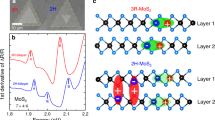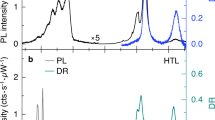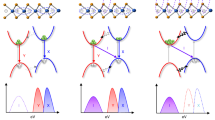Abstract
Artificial structures made of stacked two-dimensional crystals have recently been the focus of intense research activity1. As in twisted or stacked graphene layers2,3,4,5,6, these structures can show unusual behaviours and new phenomena1. Among the various layered compounds that can be exfoliated, transition-metal dichalcogenides7 exhibit interesting properties governed by their structural symmetry8,9 and interlayer coupling10,11,12,13, which are highly susceptible to stacking. Here, we obtain—by folding exfoliated MoS2 monolayers—MoS2 bilayers with different stacking orders, as monitored by second harmonic generation and photoluminescence. Appropriate folding can break the inversion symmetry and suppress interlayer hopping, evoking strong valley14,15,16 and spin17,18,19 polarizations that are not achieved in natural MoS2 bilayers of Bernal stacking20. It can also enlarge the indirect bandgap by more than 100 meV through a decrease in the interlayer coupling. Our work provides an effective and versatile means to engineer transition-metal dichalcogenide materials with desirable electronic and optical properties.
This is a preview of subscription content, access via your institution
Access options
Subscribe to this journal
Receive 12 print issues and online access
$259.00 per year
only $21.58 per issue
Buy this article
- Purchase on Springer Link
- Instant access to full article PDF
Prices may be subject to local taxes which are calculated during checkout




Similar content being viewed by others
References
Geim, A. K. & Grigorieva, I. V. Van der Waals heterostructures. Nature 499, 419–425 (2013).
Dean, C. R. et al. Hofstadter's butterfly and the fractal quantum Hall effect in moiré superlattices. Nature 497, 598–602 (2013).
Ponomarenko, L. A. et al. Cloning of Dirac fermions in graphene superlattices. Nature 497, 594–597 (2013).
Hunt, B. et al. Massive Dirac fermions and Hofstadter butterfly in a Van der Waals heterostructure. Science 340, 1427–1430 (2013).
Li, G. et al. Observation of Van Hove singularities in twisted graphene layers. Nature Phys. 6, 109–113 (2010).
Kim, K. et al. Raman spectroscopy study of rotated double-layer graphene: misorientation-angle dependence of electronic structure. Phys. Rev. Lett. 108, 246103 (2012).
Wang, Q. H. et al. Electronics and optoelectronics of two-dimensional transition metal dichalcogenides. Nature Nanotech. 7, 699–712 (2012).
Xiao, D., Liu, G-B., Feng, W., Xu, X. & Yao, W. Coupled spin and valley physics in monolayers of MoS2 and other group-VI dichalcogenides. Phys. Rev. Lett. 108, 196802 (2012).
Yao, W., Xiao, D. & Niu, Q. Valley-dependent optoelectronics from inversion symmetry breaking. Phys. Rev. B 77, 235406 (2008).
Splendiani, A. et al. Emerging photoluminescence in monolayer MoS2 . Nano Lett. 10, 1271–1275 (2010).
Mak, K. F., Lee, C., Hone, J., Shan, J. & Heinz, T. F. Atomically thin MoS2: a new direct-gap semiconductor. Phys. Rev. Lett. 105, 136805 (2010).
Zhao, W. et al. Origin of indirect optical transitions in few-layer MoS2, WS2 and WSe2 . Nano Lett. 13, 5627–5634 (2013).
Zhang, Y. et al. Direct observation of the transition from indirect to direct bandgap in atomically thin epitaxial MoSe2 . Nature Nanotech. 9, 111–115 (2014).
Mak, K. F., He, K., Shan, J. & Heinz, T. F. Control of valley polarization in monolayer MoS2 by optical helicity. Nature Nanotech. 7, 494–498 (2012).
Zeng, H., Dai, J., Yao, W., Xiao, D. & Cui, X. Valley polarization in MoS2 monolayers by optical pumping. Nature Nanotech. 7, 490–493 (2012).
Cao, T. et al. Valley-selective circular dichroism of monolayer molybdenum disulphide. Nature Commun. 3, 887 (2012).
Gong, Z. et al. Magnetoelectric effects and valley-controlled spin quantum gates in transition metal dichalcogenide bilayers. Nature Commun. 4, 2053 (2013).
Jones, A. M. et al. Spin-layer locking effects in optical orientation of exciton spin in bilayer WSe2 . Nature Phys. 10, 130–134 (2014).
Zhu, B., Zeng, H., Dai, J., Gong, Z. & Cui, X. Anomalous robust valley polarization and valley coherence in bilayer WS2 . Preprint at http://arxiv.org/abs/1403.6224 (2014).
Wu, S. et al. Electrical tuning of valley magnetic moment through symmetry control in bilayer MoS2 . Nature Phys. 9, 149–153 (2013).
He, K., Poole, C., Mak, K. F. & Shan, J. Experimental demonstration of continuous electronic structure tuning via strain in atomically thin MoS2 . Nano Lett. 13, 2931–2936 (2013).
Gong, Y. et al. Band gap engineering and layer-by-layer mapping of selenium-doped molybdenum disulfide. Nano Lett. 14, 442–449 (2014).
Mann, J. et al. 2-Dimensional transition metal dichalcogenides with tunable direct band gaps: MoS2(1–x)Se2x monolayers. Adv. Mater. 26, 1399–1404 (2014).
Molina-Sanchez, A. & Wirtz, L. Phonons in single-layer and few-layer MoS2 and WS2 . Phys. Rev. B 84, 155413 (2011).
Shen, Y. R. The Principles of Nonlinear Optics 27 (Wiley, 2003).
Li, Y. et al. Probing symmetry properties of few-layer MoS2 and h-BN by optical second-harmonic generation. Nano Lett. 13, 3329–3333 (2013).
Kumar, N. et al. Second harmonic microscopy of monolayer MoS2 . Phys. Rev. B 87, 161403(R) (2013).
Malard, L. M. et al. Observation of intense second harmonic generation from MoS2 atomic crystals. Phys. Rev. B 87, 207401(R) (2013).
Zeng, H. et al. Optical signature of symmetry variations and spin–valley coupling in atomically thin tungsten dichalcogenides. Sci. Rep. 3, 1608 (2013).
Bistrizer, R. & MacDonald, A. H. Moiré bands in twisted double-layer graphene. Proc. Natl Acad. Sci. USA 108, 12233–12237 (2011).
Sato, K. et al. Zone folding effect in Raman G-band intensity of twisted bilayer graphene. Phys. Rev. B 86, 125414 (2012).
Kim, K. et al. Multiply folded graphene. Phys. Rev. B 83, 235433 (2011).
Liu, W-T. & Shen, Y. R. Surface vibrational modes of α-quartz(0001) probed by sum-frequency spectroscopy. Phys. Rev. Lett. 101, 016101 (2008).
Acknowledgements
This work was supported by the National Natural Science Foundation of China, the National Basic Research Program of China, the Ministry of Education of China and the Shu Guang Project (grant agreements nos. 2014CB921600, 2012CB921400, 11104036, 11104033, 20110071120003, NCET-11-0110 and 11SG05).
Author information
Authors and Affiliations
Contributions
S.W.W. and W.T.L. designed the project and prepared the manuscript. T.J. prepared the sample and performed the measurements. H.R.L. and X.G.G. carried out the ab initio calculation. D.H., S.Z. and Y.G.L. built the low-temperature experimental set-up. All authors contributed to analysis of the results and writing the manuscript.
Corresponding authors
Ethics declarations
Competing interests
The authors declare no competing financial interests.
Supplementary information
Supplementary information
Supplementary Information (PDF 947 kb)
Rights and permissions
About this article
Cite this article
Jiang, T., Liu, H., Huang, D. et al. Valley and band structure engineering of folded MoS2 bilayers. Nature Nanotech 9, 825–829 (2014). https://doi.org/10.1038/nnano.2014.176
Received:
Accepted:
Published:
Issue Date:
DOI: https://doi.org/10.1038/nnano.2014.176
This article is cited by
-
Synthesis of 2D layered transition metal (Ni, Co) hydroxides via edge-on condensation
Scientific Reports (2024)
-
An anisotropic van der Waals dielectric for symmetry engineering in functionalized heterointerfaces
Nature Communications (2023)
-
Colloid driven low supersaturation crystallization for atomically thin Bismuth halide perovskite
Nature Communications (2023)
-
Modulating the intralayer and interlayer valley excitons in WS2 through interaction with AlGaN
Science China Materials (2023)
-
Moiré superlattice engineering of two-dimensional materials for electrocatalytic hydrogen evolution reaction
Nano Research (2023)



